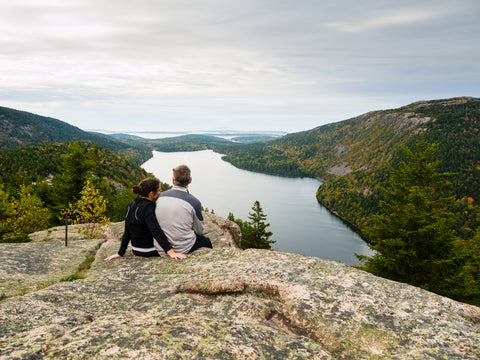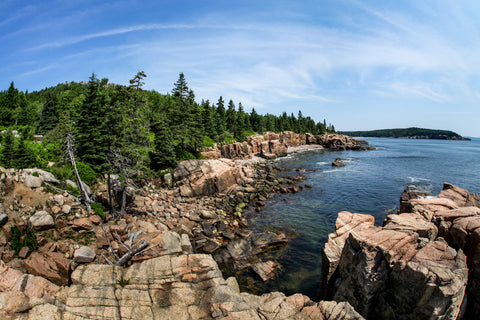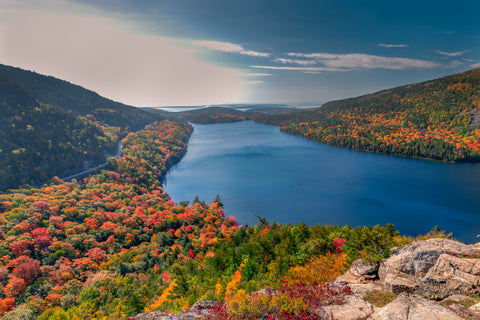Where is Acadia National Park
On the rocky shores of Mount Desert Island, along the North Atlantic Coast, you’ll find Acadia National Park. The park is a source of pride for Maine, protecting leafy woodlands, stony beaches and glistening granite peaks for recreation and conservation. The highest point in Acadia, and on the East Coast, is Cadillac Mountain. It has an elevation of 1,530 feet. The lowest point is 0 feet at the Atlantic Ocean. The town of Bar Harbor is adjacent to the park, featuring restaurants and shops.

How Big is Acadia National Park
Acadia National Park is one of the smallest national parks at just over 47,000 acres. However, it is one of the most visited parks in the nation. The park hosts more than 3 million visitors a year! Most of the park is on Mount Desert Island or conservation easements for private lands. The Schoodic Peninsula and Isle au Haut each feature a little less than 3,000 acres of the park. Acadia contains 120 miles of hiking trails and 45 miles of carriage roads.
Acadia National Park Weather
Summer is the peak season for Acadia. The lake and ocean temperatures are pleasant, between 50°F and 70°F. The weather can be a bit unpredictable. The temperature ranges from 45-90°F. The sky can be sunny and clear one minute and cold and rainy the next. Animals are active and wildflowers bloom. Fall features fantastic forest color changes. Leaf peeping is a popular pastime in Maine, especially around Acadia. The weather is variable with temperatures ranging from 30-70°F. Winter is cold. Rain and snow are common, with freezing temperatures ranging from 14-35°F. It’s a great time to visit for solitude. Spring is rainy and foggy. Animals start to become more active and wildflowers start to bloom. The temperatures range from 30-70°F.

When did Acadia become a National Park
Originally, the land that is now the park was once Sieur de Monts National Monument, established by President Woodrow Wilson in 1916, one month before the National Park Service was created. The National Monument became Lafayette National Park on February 26, 1919, named after Marquis de Lafayette, who served with Washington during the American Revolution. On January 19, 1929, the park was renamed Acadia National Park.

Things to do in Acadia National Park
The park may be relatively small, but it has a big list of things to see and do! Below are some of the most popular attractions at Acadia National Park.
Cadillac Mountain
Towering above all the other peaks at 1,530 feet is Cadillac Mountain. It’s the tallest point on the North Atlantic seaboard. It’s the first place to see the sunrise in the United States from October 7 through March 6. The mountain features several trails.
Sand Beach
Nestled between granite mountains and the shores of Mount Desert Island you’ll find Sand Beach. Behind the beach, the Beehive mountain rises in the distance. The water stays cool, never topping 55°F. Play on the beach, swim in the water, or hike a beachside trail.
Jordan Pond
Cool and crystal clear Jordan Pond is a glacier formed tarn. At its deepest, the water is 150 feet. While swimming is not allowed, Jordan Pond is a popular kayaking and canoeing destination. The pond is close to the restaurant, gift shop and Carriage Road.
Carriage Road
Acadia contains 45 miles of carriage roads, roads that are made of broken-stone and are approximately 16 feet wide. They were made to stand up against the rainy weather of Maine. Birdwatching, picnicking and biking on the path are very popular activities along Carriage Road.
Bass Harbor Head Lighthouse
The Bass Harbor Head Lighthouse stands 56 feet above sea level on a rocky cliffside. The lighthouse is open daily from 9:00 am to sunset with free parking. Climb the tower of the lighthouse to reach a vantage point overlooking the harbor and islands.
Thunder Hole
Experience the mighty power of the ocean at Thunder Hole. It is a small inlet, naturally formed by rock erosion. There’s a small cavern at the end of the inslet. Waves beat against the rocks, pushing air into the cavern and causing a thunderous roar.
Animals in Acadia
Acadia has a unique animal population. You’re likely to see dolphins and whales off the coast. There are many birds in the US National park. Most notable are peregrine falcons and herons. The forest is full of salamanders and frogs. You might even spot a Maine moose!
Frenchman Bay
Named after French Explorer Samuel de Champlain, Frenchman Bay is a peaceful bit of paradise. The bay is full of islands, including the Bald Porcupine, Bar Island, Sheep Porcupine and Long Porcupine Islands. At low tide you can even walk to most of these islands.
Park Loop Road
Park Loop Road is the main route to navigate around Acadia. It stretches 27 miles and loops around the park. Along the way there are pull-off observation points with views of the bay, ocean, a surrounding forest. Be sure to drive slow - wildlife is abundant!

Hiking Trails
There are 120 miles of hiking trails to explore in Acadia. The hiking trails range from very easy to strenuous. Take the Wonderland trail and investigate tidal pools and the shore. Take a tour of the vistas of Frenchman’s Bay on the Champlain Mountain trail.

When to go to Acadia National Park
There is no wrong time to visit Acadia National Park. The best time depends on what you want to see and do while you’re there. Summer is incredibly popular. The weather is pleasant and the temperatures are the warmest of the year. However, the park is crowded. Winter is a magical time where the crowds have gone and the coast is glistening. Spring is an excellent time for birdwatching and wildflowers. It’s a good time to hit the trails. Fall is seen as the best time to visit Acadia. Maine is known for spectacular fall foliage displays. The crowds are thinner and the weather is perfect for hiking. Fall is also the only time to enjoy the Night Sky Festival.

Must-Have things to bring to Acadia
It is important to have the proper supplies when you’re out in nature. We’ve listed a few items you’ll definitely want while you’re out and about in Acadia National Park.
Park Map
You don’t want to get lost while you’re out having fun. Avoid this by bringing a park map. You can pick one up at the visitors center or print one ahead of time. It’s good to have a digital copy on your phone or GPS.
Bug Repellent
Insects can be a real nuisance in Maine, especially in late spring or early summer. Black flies, mosquitoes and ticks are widespread throughout the park. Avoid being bugged on your trip. Bring some bug spray or another type of repellant, for you and for pets!
Sun Protection
Save yourself from the sun’s powerful rays. The ultraviolet light it puts off is extremely damaging to skin and eyes. Wear a wide-brimmed hat and sunglasses to keep sun off your face, stay cool, and minimize exposure risks. Wear sunscreen to protect yourself from sunburn.
Multiple Clothing Layers
It’s very chilly at a moments notice in Acadia National Park, especially while you are hiking up mountains. Make sure you pack multiple layers. Long-sleeved shirts, jackets and a decent coat are a good place to start. Hats and gloves are a good idea too.
Waterproof Rain Jacket
Rain is very common on the East Coast. Showers can start at any time during any season. With the rain comes dropping temperatures. You need a good rain jacket to keep you dry and warm. Pick a jacket that is fully waterproof, windproof and lightweight.

Comfortable Shoes
You’ll be spending a lot of time on your feet and walking while you’re at Acadia. You should bring along shoes that are comfortable and broken in. Shoes that are waterproof are a plus. Or bring a pair of sturdy water shoes with you too.
Headlamp
Getting around camp at night will be much easier if you wear a headlamp. The park is dark, offering excelling views of the starry sky but less so of where you are going. You don’t need anything fancy, a simple headband-style lamp will work fine.
Water
You won’t find any fountains out on the park’s trails. You should bring water with you on your adventures around the park. In conjunction with water bottles, you can bring along a hydration filtration device, which allows you to filter and drink water from streams.
Food/Snacks
Food options are limited inside the park. You’ll want to bring your own food and snacks, especially if you plan on doing any lengthy hikes or are staying overnight at the park. Choose non-perishable products or bring a cooler to store items that need refrigeration.Storage Bags
You’ll need to “pack out” what you “pack in” at the park. This means whatever you bring should leave with you, including trash. Plastic baggies are great for storing trash as well as saving items you don’t want to get wet like phones and maps.

Where to stay in Acadia National Park
Our National Park Visitors Guide about Acadia National wouldn't be complete without lodging options. And Acadia Park features limited lodging opportunities. There are no lodges, hotels or cabins in the park. Backcountry camping is not allowed. You may only camp at designated campgrounds in Acadia. There are three campgrounds spread between Mount Desert Island and the Schoodic Peninsula. There are also five lean-to shelters on Isle au Haut. Campgrounds open on August 1st. You’ll find plenty of places to stay outside the park, including private campgrounds, hotels and rentals.
Food Nearby Acadia
You’ll find only one dining option in Acadia National Park. The Jordan Pond House Restaurant serves lunch, tea, and dinner. It features indoor and outdoor seating. The restaurant is only open from mid-May through late October. Most visitors bring their own food. The neighboring towns around Acadia have tons of great options for drinks, desserts, delicious cuisine and fresh seafood.
Airports near Acadia National Park
If you plan on flying in for your visit to Acadia, you’ve got options. If you’re nearby, you can take a direct flight from Boston's Logan Airport to the Hancock County Airport. From there you’ll only be 10 miles from the park. Bangor International Airport is about an hour from Acadia National Park. It services most national and international airlines.

